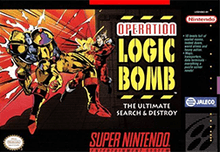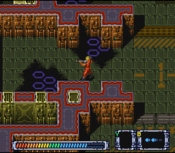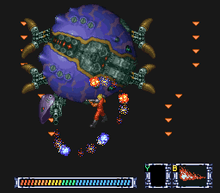Operation Logic Bomb
| Operation Logic Bomb | |
|---|---|
 North American cover art | |
| Developer(s) | Jaleco |
| Publisher(s) | |
| Designer(s) |
Yasuo Igakura Yutaka Sakashita |
| Artist(s) |
M. Matsuda Tomoji Omotani M. Shimura |
| Composer(s) | Yasuyuki Suzuki |
| Platform(s) | Super NES/Famicom |
| Release | |
| Genre(s) | Action |
| Mode(s) | Single-player |
Operation Logic Bomb: The Ultimate Search & Destroy, known in Japan as Ikari no Yōsai (怒りの要塞 "The Fortress of Fury") is a 1993 overhead action video game developed and published by Jaleco for the Super NES/Famicom. It was first released in Japan on April 23, 1993, and later in North America in September 1993. It is the second sequel to the Game Boy game Fortified Zone, following the Japan-only Game Boy sequel Ikari no Yōsai 2. Although the Japanese version shares the same title as the original Game Boy game, it isn't a remake. It was later re-released as BS Ikari no Yōsai on the Satellaview system.
Plot
A group of people have joint ambitions to establish an unprecedented scientific theory. They called it the "crystalline substance transfer theory in dimensional physics." This helped to accomplish the rapid progress in recent years. The fear of leaks of confidential material is a huge expense that the leaders could not possibly afford. As a result, all the research was done on expansive grounds in a nationally sponsored facility that was built behind the rocks.
However, because the near future also demands practical research, the people lost contact with the scientists working at the facility. Defense forces are immediately dispatched to an elite survey of troops. A sky reconnaissance plane was shot down last; forcing the area to go into a state of emergency.
Gameplay

The player has to liberate a secret futuristic laboratory dealing with interdimensional physics from monsters that escaped through a rip in the dimensional fabric of space and time. There are lots of robots and big bosses to fight as the main character liberates his comrades from being trapped inside sections of reality that are turned into a representation of the virtual world.
Controlling a cybernetic soldier, the player starts out with two basic weapons and gains more as he progresses throughout the game. Computer memory banks will permit the player to tap into memories in order to solve the problem once and for all. All of the weapons are essential if the player wishes to beat the game. Enemies include common soldiers, cannon launchers, giant flying robots, and the extremely low amount of continues (3) allowed.
Player character
- HIRO/Agent Logan
- The protagonist of this video game. He is assigned the code name "HIRO" after being recruited. HIRO is a warrior whose capabilities are far beyond the limits of normal humans. Through enhancements, he has become an excellent soldier. Resistant to red bullets while wearing heat-resistant suits that wrap his body and his nervous system.
- He is called Agent Logan in the Western release of this video game.
Equipment
- Spatial transition unit-device produces world here and nitrous space. One Sanya space biology who made by force transfer machine development staff. Performance seems to be, insufficient cannot only sparsely spread to certain regions. Annihilate enemy, and disappeared from the area was light blue things to destroy this device called nitrous space contact honeycomb pattern belt equipment also destroy the equipment in that area. Things we repair the thing enemies with this device, destroying enemy space turned into world has become the object of the game.
- Console-recording equipment installed in the trenches for a record experiment Research Center terminals. Watch the video to find out what lamp is lit, map of the area was recorded in the recovery of life, get the console as quickly as possible. There is console to recover damage while trying to annihilate the enemy.
- Transfer machine-short haul materials transfer machines. As the Transportation Research Center, was used in the experiments. Players can make the area between objects that are lit on the ride. Transfer machines recover feature is taking action to destroy the space transition unit also exists.
- Name unknown-items appearing in the game towards the end. Players have the ability to change color of HIRO while moving into enemy space.
Weapons
Ordinary
- Machine guns (STRAIGHT ARROW)-initial equipment. Fire a projectile forward without tearing.
- 3-WAY (SPREAD EAGLE)-initial equipment. Projectiles are fired in three directions. Turbo speed is less than the machine guns.
- Reflective laser (R-LASER)-The laser hits obstacles such as walls, and reflections from the blind spot of the enemy attack to make possible to fire.
- Flamethrower (FIREBUG)-Short range, but the power is usually the highest of the weapions. Diagonally from barriers and obstacles along flame, go make attacks from the blind spot of the enemy is possible. However, it is ineffective on some enemies.
- Missile (MISSILE)-Considered to be the "hidden weapon", the player can reclaim it unlike the other weapons.
 An example of gameplay
An example of gameplay
Special
- Directional mines (CLAYMORE)-These are the so-called Claymore mines that are available in the middle of the game. All these weapons are in the highest power possible.
- Decoy (DECOY)-The player acquires this weapon in the middle of the game. HIRO's hologram can actually attract the enemy to the optical illusion.
Reception
Allgame gave the game a rating of 3.5 stars out of a possible 5, stating that while it is not as intense as Super Smash T.V. or Contra III: The Alien Wars, it rightfully serves as an intriguing game of "search and destroy."
References
External links
- Operation Logic Bomb at MobyGames
- Operation Logic Bomb at GameFAQs
- Ikari no Yōsai at Jaleco (in Japanese)